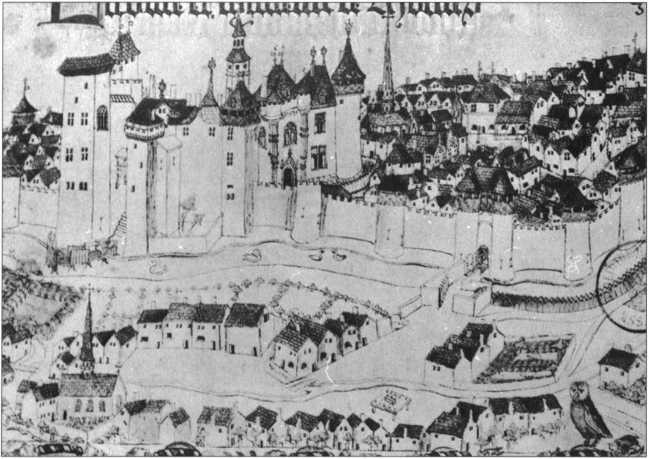m3374
tor being almost any form of tower, a bastida being a new village or town that need not be fortified, a dongo being the Southern term for a donjon castle, a borgada being a fortified town or large village, and a mota probably being a place with a moat.
Fortified towns were, of course, the most important, and although their populations were periodically reduced by plague they were soon replenished by incomers from the countryside. Towns also co-operated closely with one another in defence, distribution of supplies and the sharing of information. They also posted early warning observers in the surrounding countryside in times of trouble, using smoke signals, bells, flags and other means of spreading the alarm. Rural villages appear to have done the same on a smali scalę, while feudal lords similarly exchanged information with urban authorities. The primary function of such arrangements was to obtain knowledge about troop movements and the activities of roving companies, and to find out who was and who was not prepared to pay the patis protection money demanded by armed bands. Information on enemy strengths and actions could be remarkably precise, as shown in surviving documents.
‘The City of Moulins’ in a mid-15th century manuscript by Guillaume Revel. This intriguing illustration of a medieval city as it really looked inciudes the old town within its walls and a new citadel gate, as well as less crowded suburbs in the foreground. (Armourial d’Auvergne, Bibliotheque Nationale, Ms. Fr. 22297, f.369, Paris)
The decision to extend or update a town’s fortifications was an important one. Although it could be very expensive, a reputation for ‘impregnability’ was good not only for deterrence but also for trade, and fortification was, in fact, seen as an investment. Once Royal approval was obtained the necessary land had to be compulsorily purchased, compensation paid for the destruction of houses and vineyards, lengthy legał processes completed, and special taxes called festage raised. Local manpower and materials would be usecl but outside experts could be recruited. People were also fully aware of the aesthetic aspects of new fortifications, sińce these reflected a town’s status.
The higher nobility of France took responsibility for much modernisation of fortifications, including the adding of massive new gates to towns within their jurisdiction. They also tended to focus upon fortresses associated with the prestige of their own local dynasty; for example,

the Duc de Berry not only strengthened his castle at Bourbon FArchambault with massive towers but added a magnificent new banqueting hall - it was felt to be increasingly important for the aristo-cratic elite to maintain their status through conspicuous consumption.
Sonie detailed estimates of what was needed to defend such castles are found in the writings of Christine de Pisań in c.1408. She stated that a garrison of 200 men required 24 arbaletes a tilble (smali cross-bows), six arbaletes a tour,
34
Wyszukiwarka
Podobne podstrony:
The Bank or its Officers will not be held responsible for the genuineness/authenticity of other docu
use 1 strand NOTĘ: Any form of reproduction of this pattern constitutes an infringement of intellect
ingly any form of the class rule. Therefore, the proletariat as the class whose historical interests
Future Perfect Progressive rttrl to emphasize or show that it will be a long time fule ; = to emphas
- 4 - estimated that natural regeneration will not be able to satisfy the fuelwood needs of the citi
screenshot 3 <7—wp-html-compression no compression—> This is a bunch of content that will not
CHAP. II.—ON RINGING ROUNDS. Any number of bel]s, tuned in the diatonic scalę and hung in a tower, i
377271ae4e10e602d3a579b8117f4ecb Copyrighted Materiał The Buddhist goddess of compassion Guan Yin ca
font adjust a thafs right - all of these are at the same point (em) size. In CSS, any one of theseSe
have got practice 2 H/WE/HAS GOT Practice Time! I.Wfite the short form of ho c goi/has aoł/havo not
Kcierences oiDiiograpmąues Luoma S.N., Bryan G.W., 1981. A statistical assessmerntof the form of tra
więcej podobnych podstron